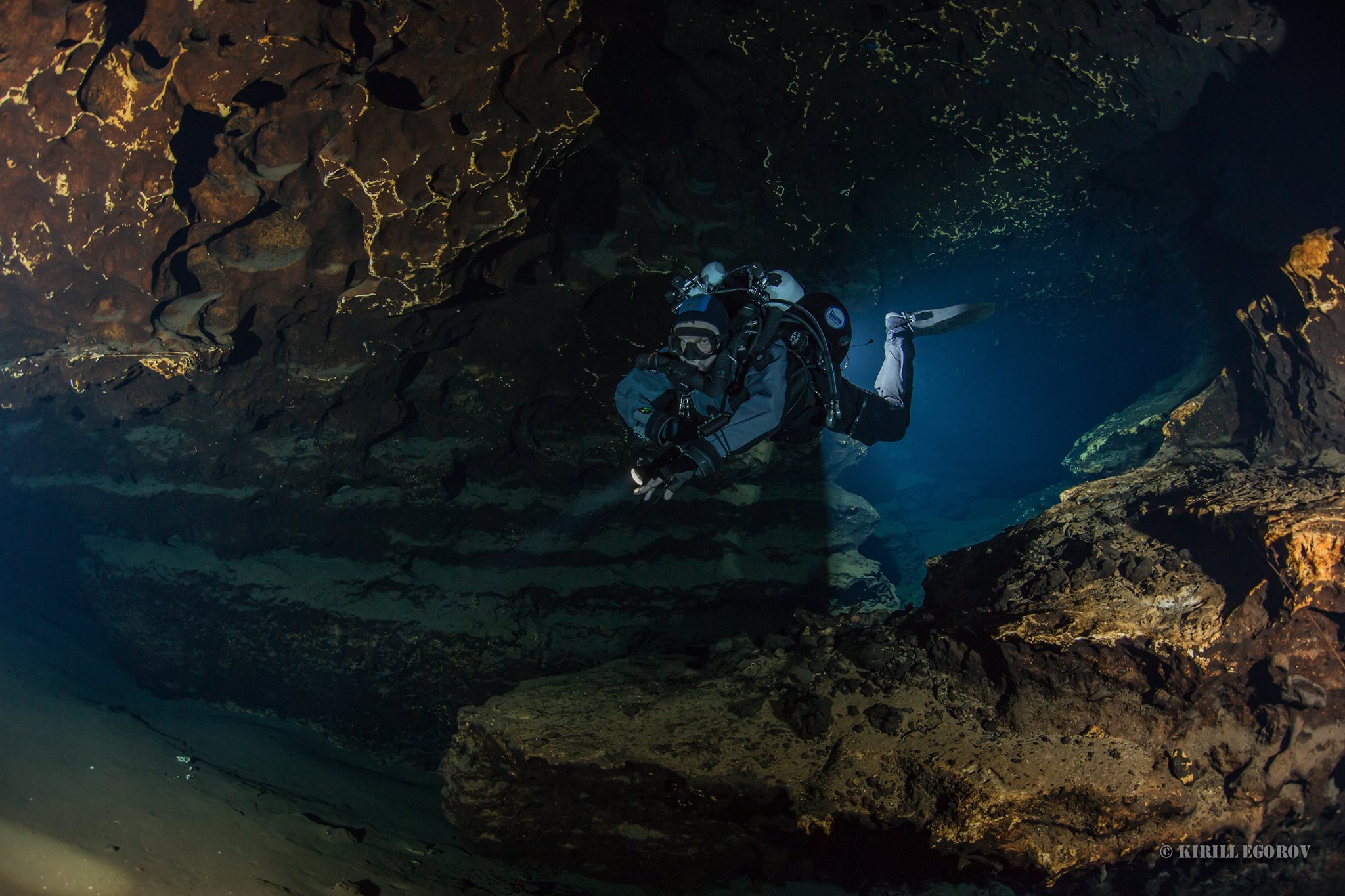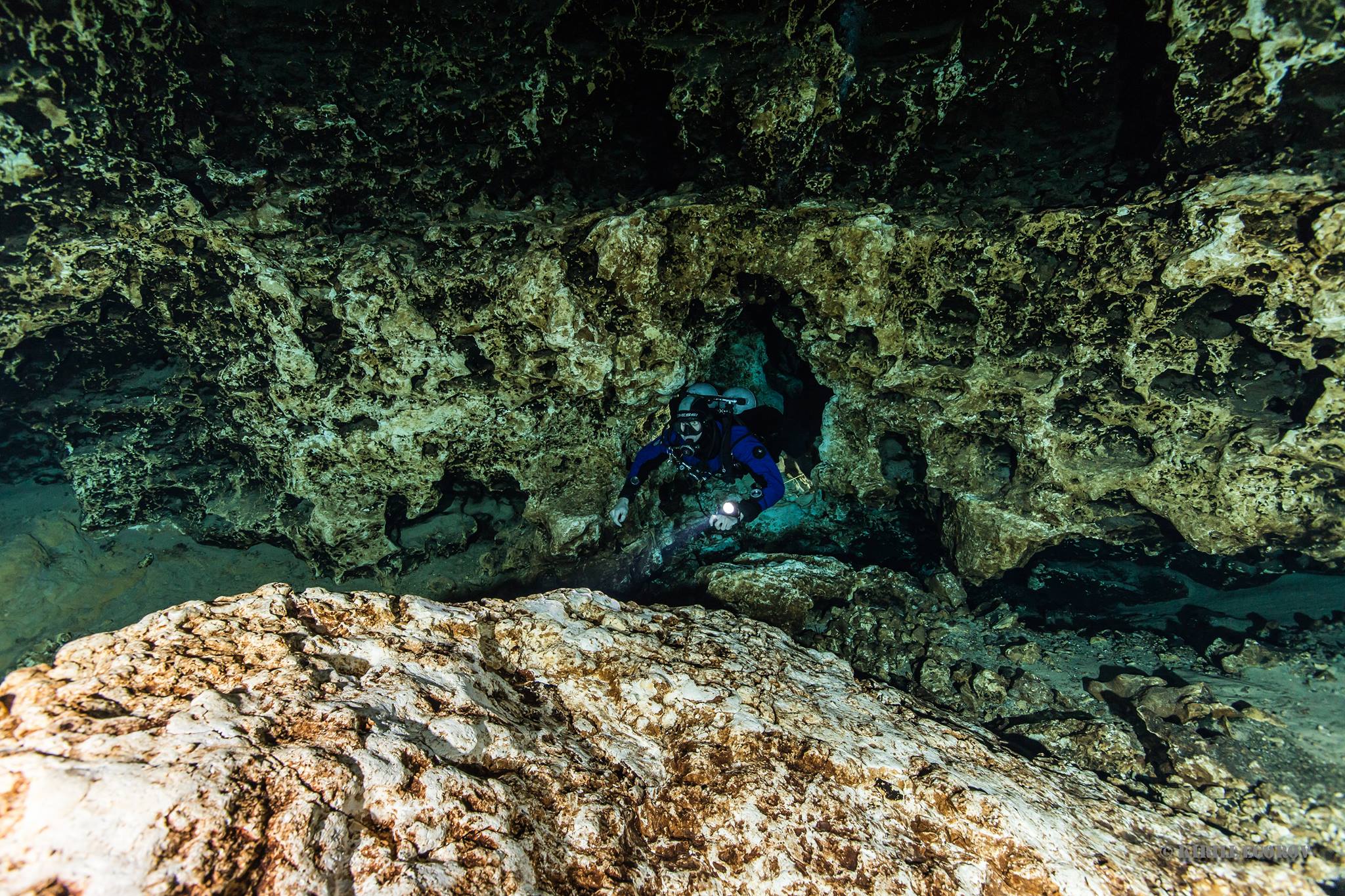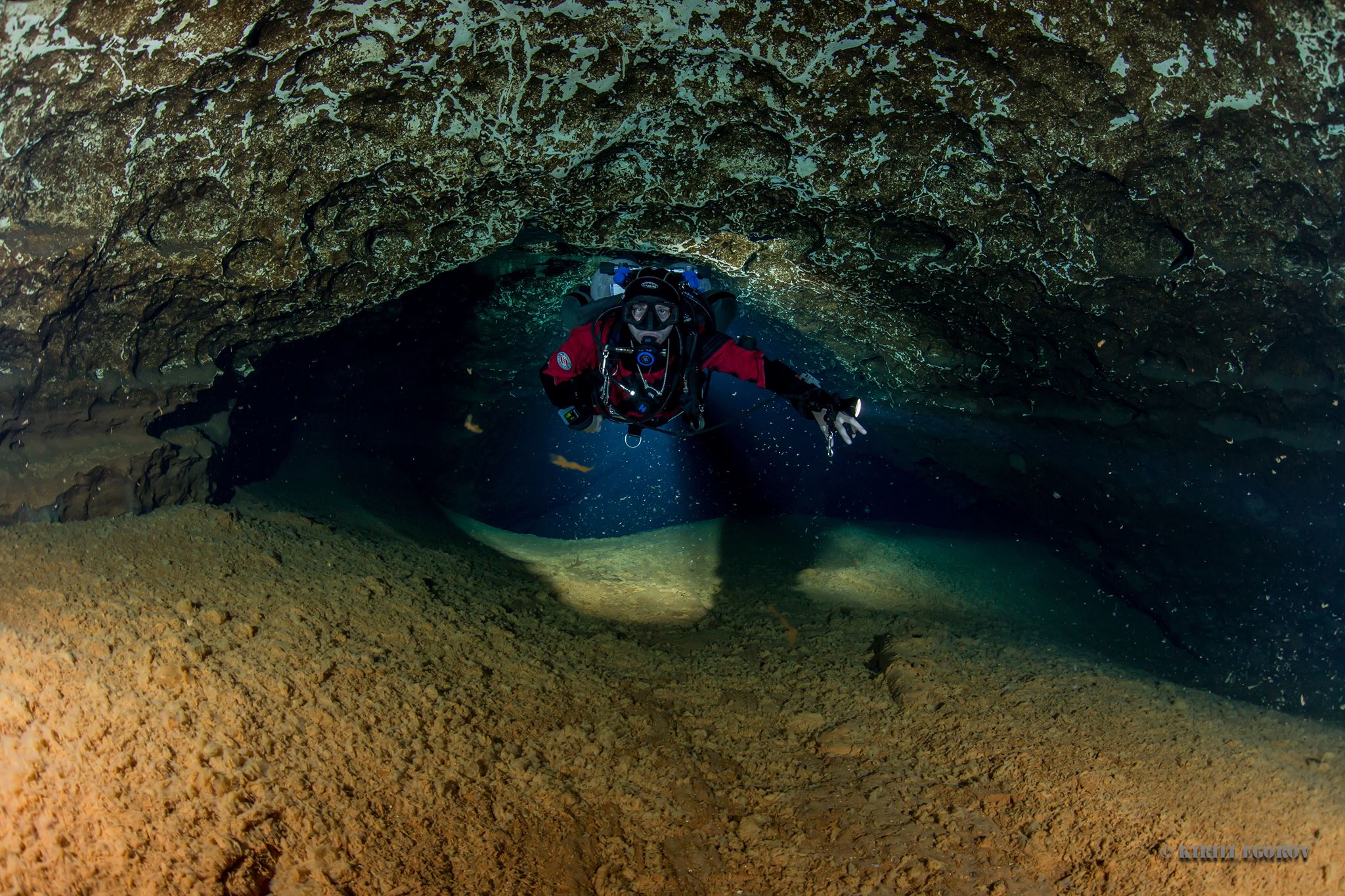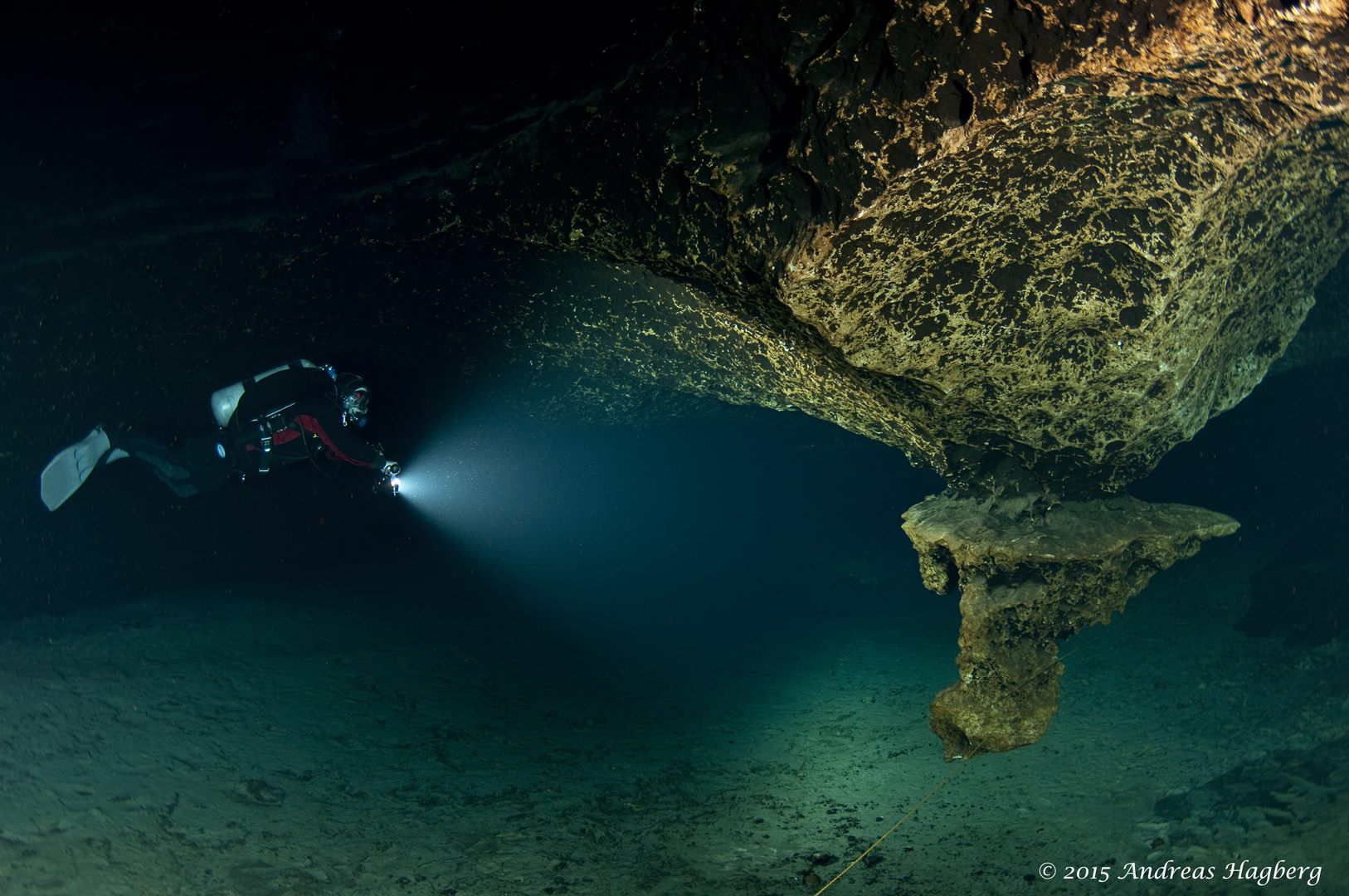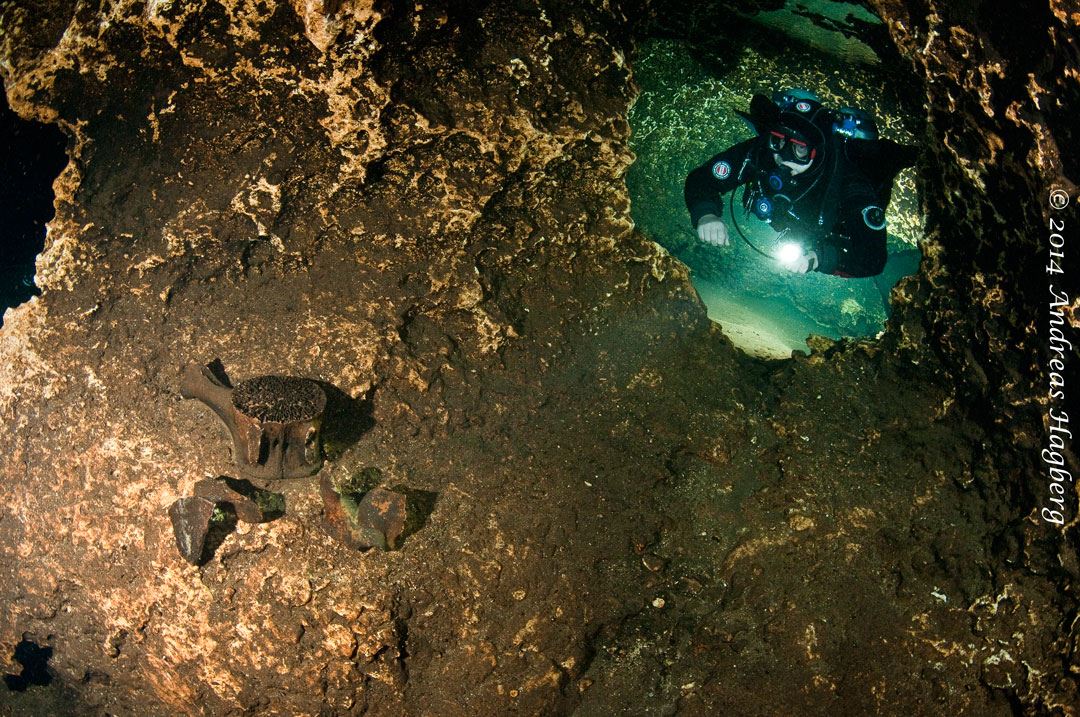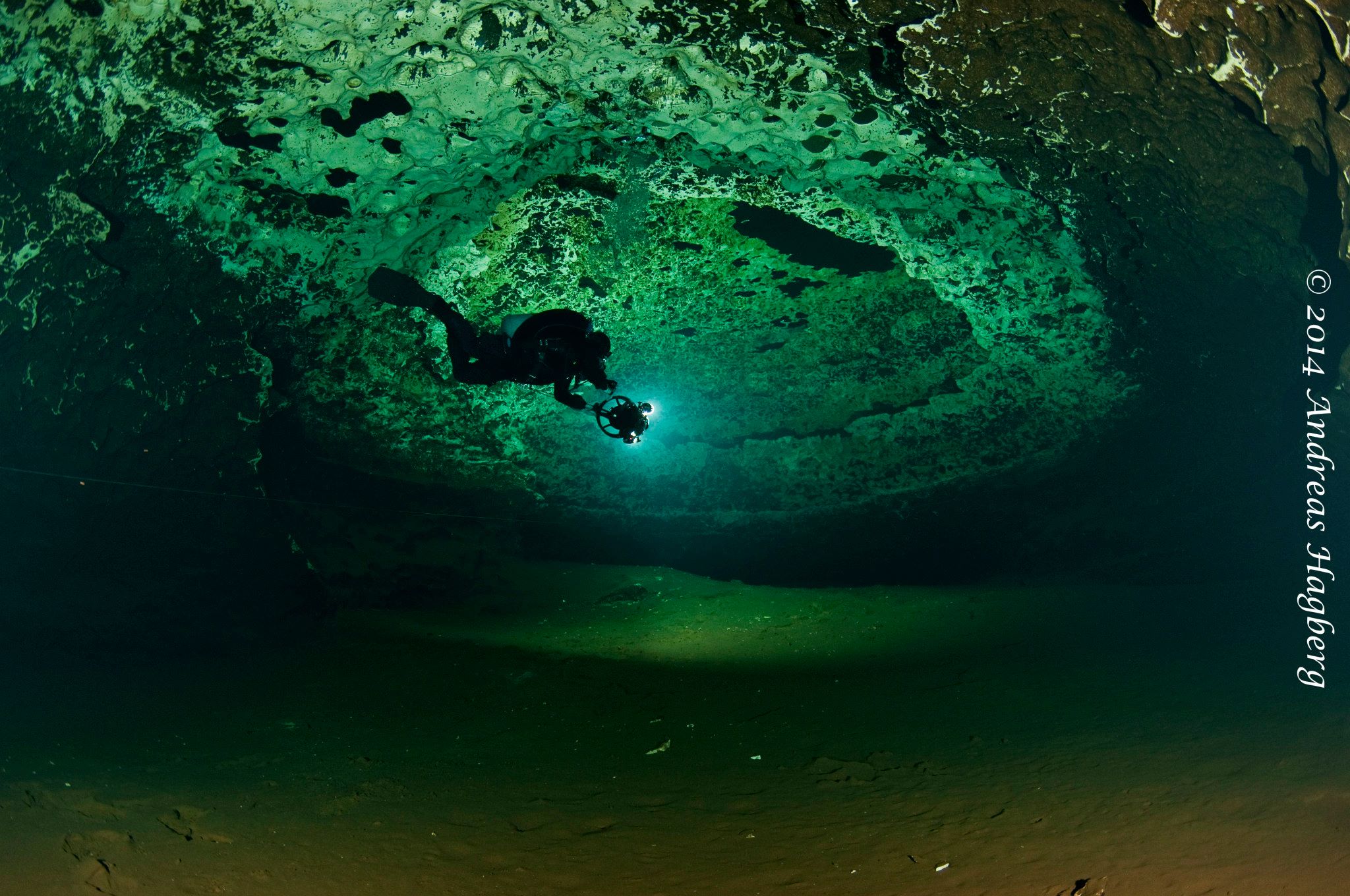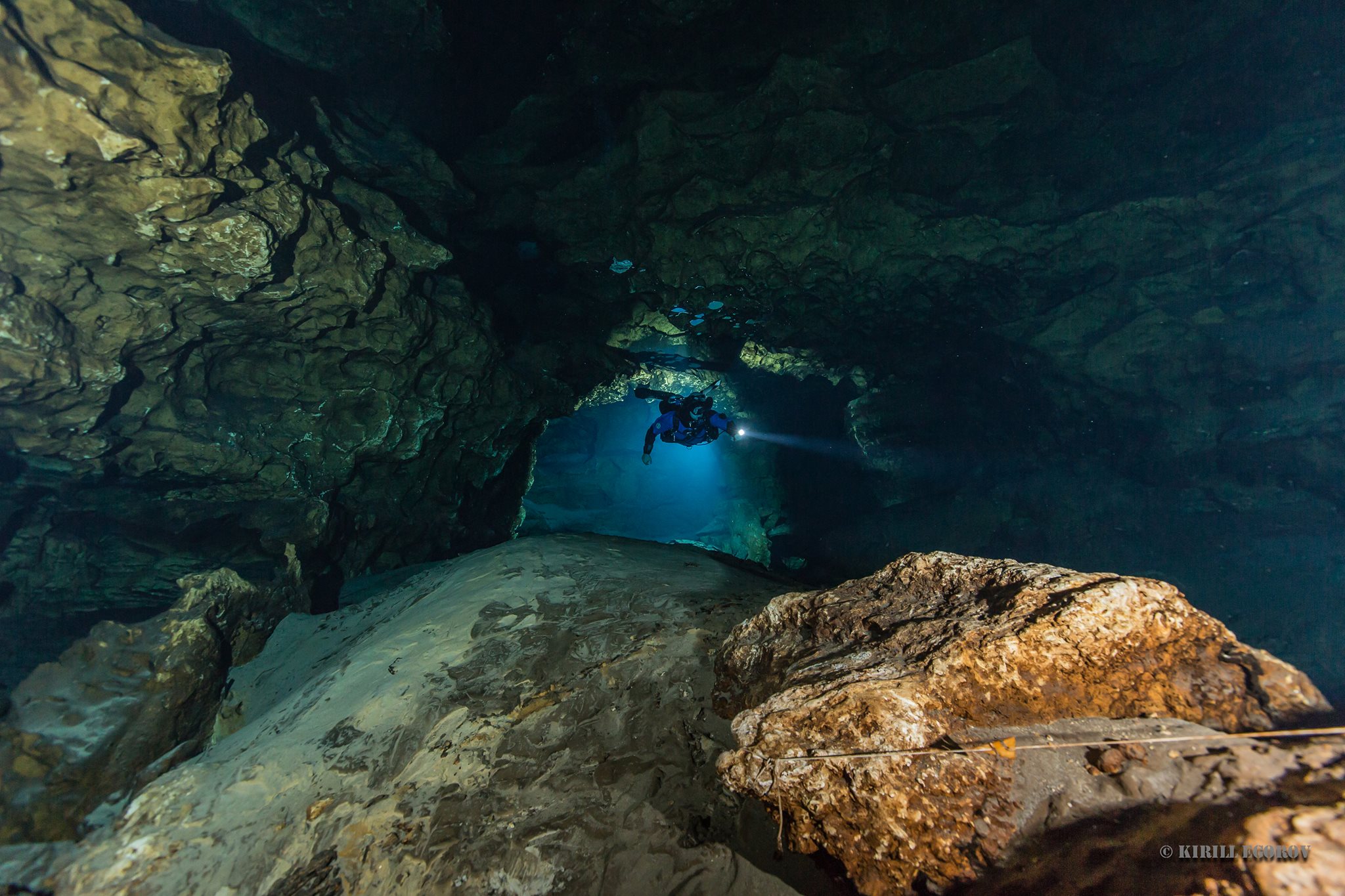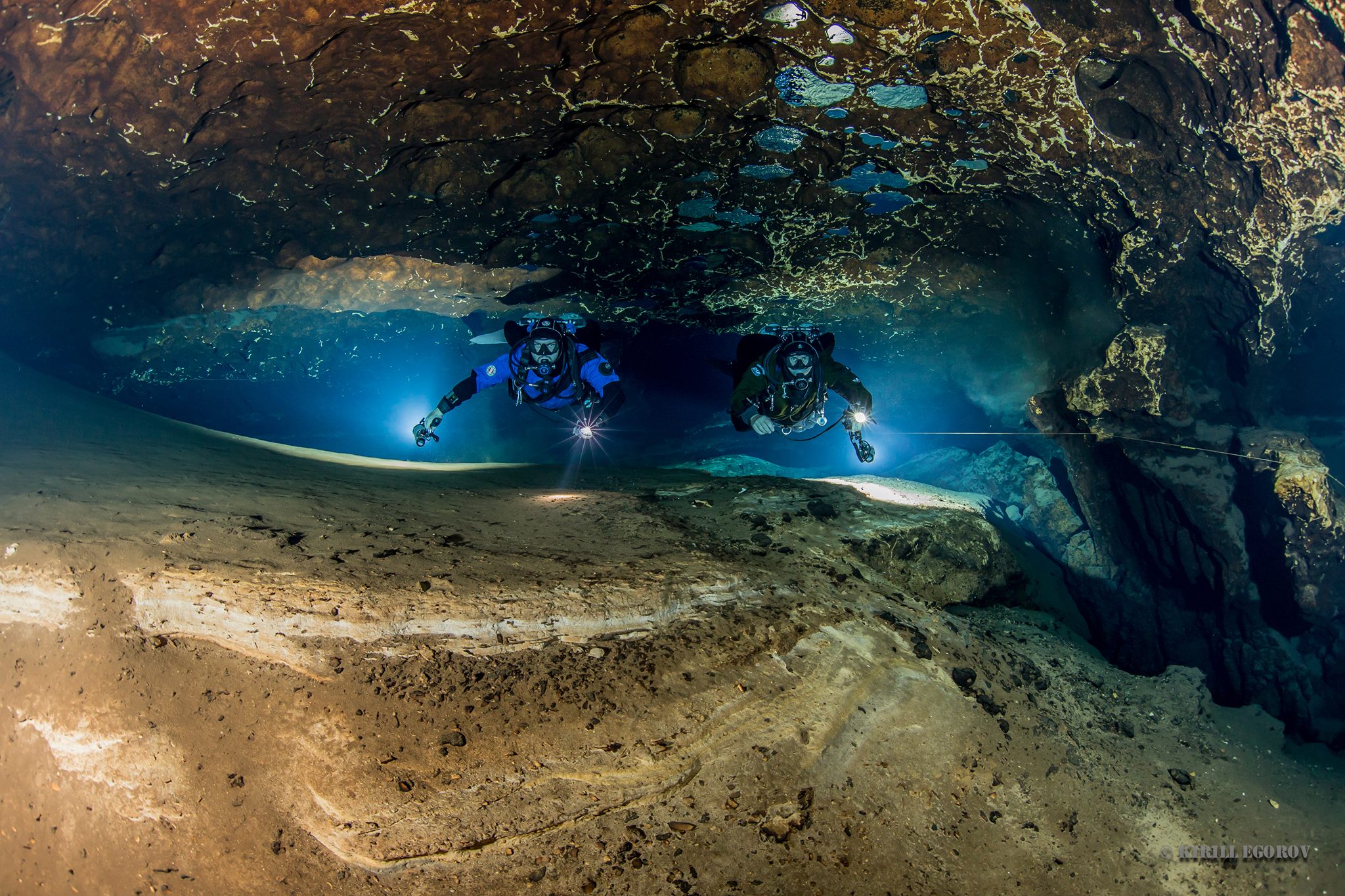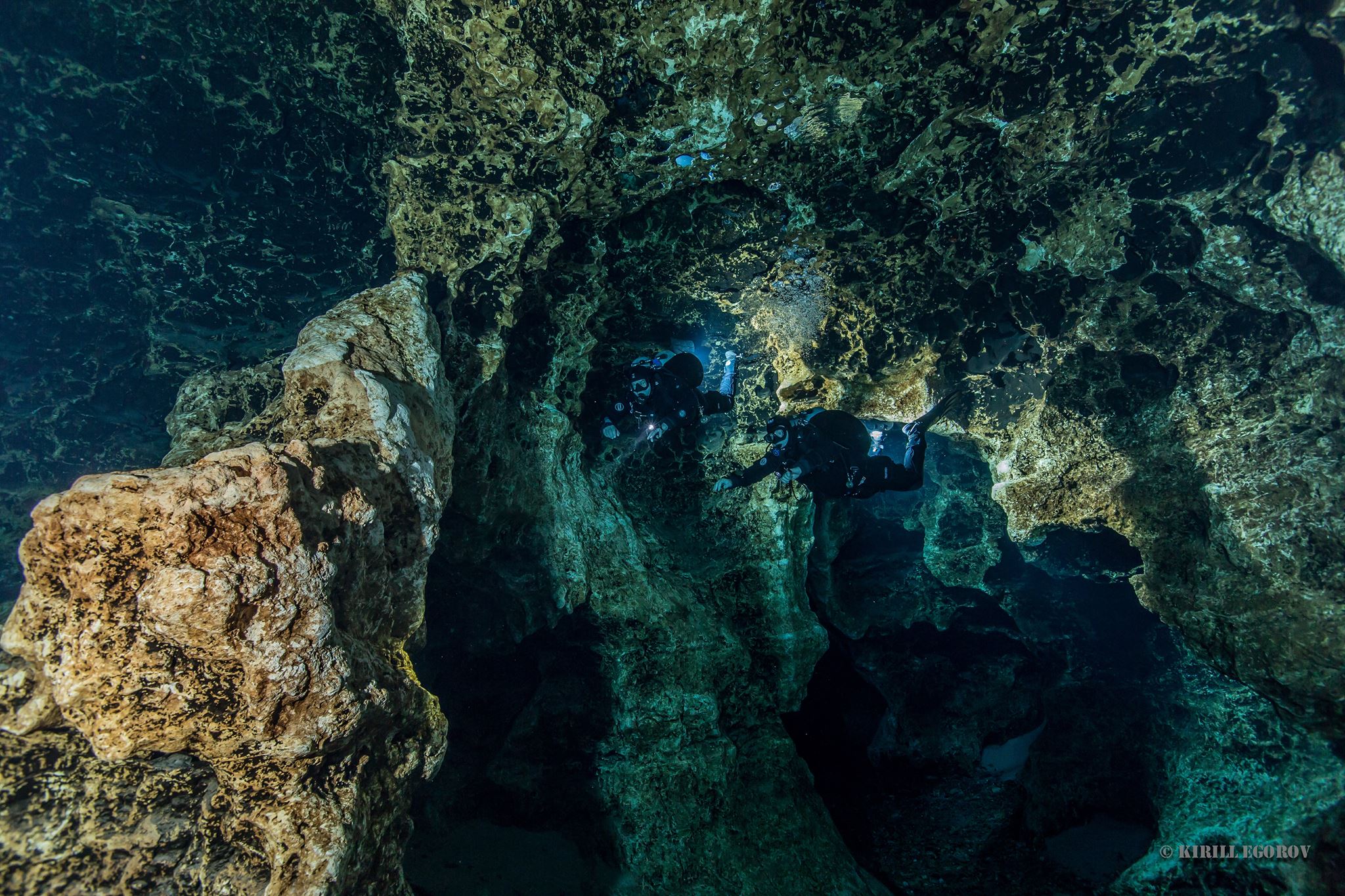
Location
Ginnie Springs is one of the world's most popular fresh water diving locations and provides an array of excellent diving activities. From shallow spring and river diving to excellent cavern and cave dives Ginnie has something for divers with a variety of experience. Ginnie Springs is a 200 acre campground and diving facility complete with a fully stocked dive shop, air compressor and rental equipment. Due to a high spring discharge from seven springs on the property this region usually has 200' visibility throughout the year. Five of the seven springs found on the property provide excellent diving activities while the remaining two springs are better left to snorkeling or swimming. Admission to Ginnie Springs for cave divers is $22 per day; yearly passes are available for $330.
More Ginnie Springs dive information.
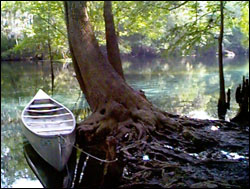
Ginnie Springs Run
Ginnie Springs Basin
The large basin at Ginnie Springs is an excellent area for swimming, snorkeling and openwater diving with visibility often described as "air clear". The spring basin has a maximum depth of 20' and an average discharge of approximately 20 million gallons each day. This crystal clear spring water flows out to the Sante Fe River providing divers with unique access an occasionally clear river. For properly experienced divers Ginnie Springs has a large, reasonably benign cavern called the ballroom with a maximum depth of 50'. The cavern contains a large permanent guideline and is grated off to prevent any meaningful cave penetration.

Across Devil's Eye, from the end of the Little Devil Run
The Devil Spring System
The Devil's Spring System is comprised of three different springs: Little Devils, Devil's Eye and Devil's Ear. This collection of springs forms a 300' long by 20' wide run, discharging roughly 40 million gallons of water to the Sante Fe River. This run and its collection of springs make for enjoyable though generally shallow openwater diving. Divers without cavern or cave training are not allowed to bring an underwater light into the Devils area. The "no lights" rule is designed to prevent inexperienced divers from entering the dark overhead region and becoming lost.
General Information
The Devils Ear cave system is one of the most well known cave dives in the world with thousands of visitors every year. Very few cave divers visiting Florida have not experienced at least one dive in this unique system. The large tunnels, crystal clear water and tremendous variety found within this cave attract divers with varying experience. From the budding cavern diver to the advanced cave diver divers are always able to enjoy the challenge of the Devil's System.
The Devil's Spring System is comprised of three different springs: Little Devils, Devil's Eye and Devil's Ear. This collection of springs forms a 300' long by 20' wide run, discharging roughly 40 million gallons of water to the Sante Fe River. This run and its collection of springs make for enjoyable though generally shallow openwater diving. Divers without cavern or cave training are not allowed to bring an underwater light into the Devils area. The "no lights" rule is designed to prevent inexperienced divers from entering the dark overhead region and becoming lost.
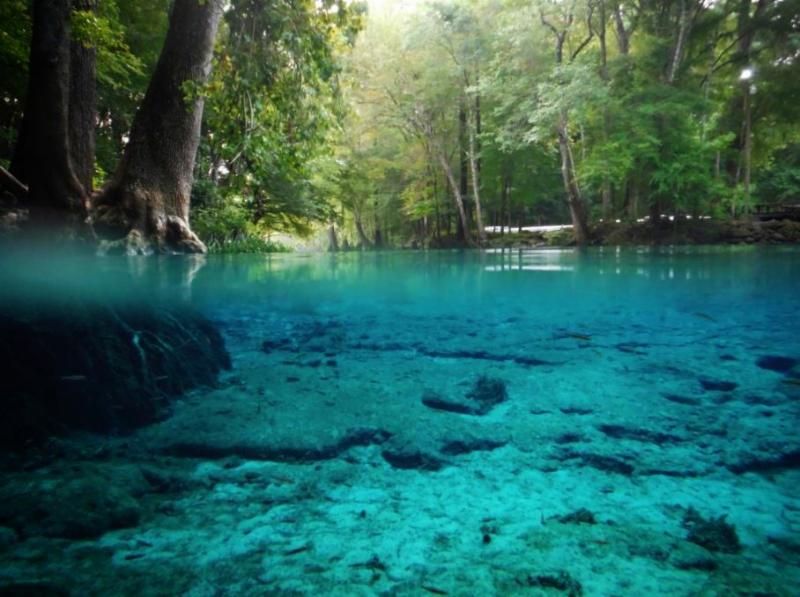
Little Devil Spring Run
Little Devils Spring is a 50' deep fissure that is no more than 4' wide at any point. While this feature is relatively small and limiting it is a unique area worthy of a short sightseeing tour. The bottom of the fissure contains two very small caves neither of which have any notable cave penetration. The upstream or spring side is about 500' of sometimes "no mount" tunnel requiring that the diver push their tank in front of them while the downstream or siphon side is very brief and silty. Neither opening is currently accessible, having been naturally filled in over time. Both areas require advanced cave diver training.
Devil's Ear and Eye
Devils Ear and Devils Eye Springs connect to one another providing access to roughly 30,000' of fabulous subterranean conduits. These two springs connect through a restrictive passage that is too advanced for divers without cave diver training. Cavern divers must limit themselves to the small but interesting cavern found within the Devil's Eye. The restrictive tunnel leaving this cavern joins with the main conduit in Devil's Ear opening into a large series of branching tunnels with a maximum penetration of 4,300'.
Devils Ear Spring is the more common diving entrance complete with a cavern area for certified overhead divers. However, this large spring emits a strong flow of 30 million gallons per day making diver access somewhat challenging.
The Main Passage
The main passage in Devil's Ear cave is often the size of a semi-tractor trailer as it winds a course through thousands of feet of crystal clear water, finally becoming too small for diver access at nearly 4,500' from the surface. Numerous passages full of interesting variety branch from the main conduit providing divers of all experience levels with a challenging environment. While there are literally hundreds of different areas to visit within the Devil's Ear cave system, five primary paths contain the most popular diving destinations. These destinations include: the Main line, the Right line, Hill 400, the Double lines and Mainland.
The Main line in Devil's Ear begins approximately 100' from the entrance, just beyond the sunlit cavern zone. Near the entrance, the main conduit is roughly 20' tall by 20' wide and will vary in size during its long upstream migration. Within approximately 100' divers will reach a popular bedding plane formation known as the lips. The cave narrows to only a few feet tall and several feet wide at this location but almost immediately opens into more formidable cave.

The Lips
Following the passage another 50' divers will encounter the keyhole restriction leading to another briefly confining area known as the cornflakes. The short pass through the cornflakes leaves divers in a somewhat larger area known as the junction room. From here the diver may continue on the main line or divert to the Right line. The Right line path requires that divers leave the main line using a jump spool and therefore, should only be pursued by experienced full cave certified divers. Prior to attempting any of the many side passages branching from the main line divers should gain experience in the large and beautiful travels along the main passage. This main conduit continues for a total of 3,200' before narrowing at the Hinkel restriction, continuing in smaller (no scooter) passage for another 1,000'. The mystique of this popular area should not entice unqualified divers to push beyond their limitations. Many people have lost their lives in careless, unqualified pursuits of this nature.
Bone Room/Big Room
The Right line may be pursued by qualified full cave certified divers and branches from the main line at the junction room some 300' into the cave. The upstream swim on the Right line brings divers through the bone room into the Big Room finally reuniting with the main line some 500' later. While only about 150' long the Big Room is one of the largest tunnels in the Suwannee River Basin cave diving region. Branching from the Bone Room is the beautiful and unique White Room. Aptly named for its white limestone walls and ceiling this room appears to be fed by a clear spring source tunnel, often noticeably clearer than the main passage. The White Room jump is some 30' off the main line and has a restrictive entrance limiting this area to more experienced cave divers. Like many areas of Devil's Ear this region must be treated with care as blossoming interest threatens to damage these beautiful features.
Hill 400
The Hill 400 area leads to a vast array of more advanced diving areas. Some 400' from the entrance the Hill 400 line is a large passage on the left side of the main conduit. Again only full cave certified divers should attempt to explore this region. The Hill 400 tunnel itself remains relatively large generally measuring at least 10' by 10' but contains numerous side passages with silty conditions and reduced size. The most popular of these regions is known as the double lines and contains an array of smaller often single file passages that wind back and forth through their limestone host. The double lines area has suffered noticeably from the expansion of cave diving popularity. Many of these tunnels become quite small and only those with excellent buoyancy skills and refined cave diving techniques should enter this region. Advanced Full cave divers looking for an interesting tour could follow the Hill 400 line along its roughly 1,500' course through the Hiller Tunnel and back to the main passage or shortcut out of that circuit at the roller coaster. However, divers attempting dives of this nature must be sure to gather all the necessary information, insuring that they understand the potential danger of longer and more complex penetrations.
Mainland
Mainland is located slightly more than 3,000' from the entrance and some 100' before the Hinkel restriction. While several of the larger areas in Mainland widen significantly this region is limited to experienced full cave divers. Some areas in Mainland are fairly small, single file restrictions with a high silt potential. The Mainlands area is often clouded by tannin stained water percolating into its interior sometimes significantly reducing visibility. However, for highly skilled cave divers willing to accept the often reduced visibility this region has several large rooms and interesting passages.

